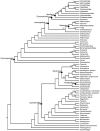The braincase of Eocaecilia micropodia (Lissamphibia, Gymnophiona) and the origin of Caecilians
- PMID: 23227204
- PMCID: PMC3515621
- DOI: 10.1371/journal.pone.0050743
The braincase of Eocaecilia micropodia (Lissamphibia, Gymnophiona) and the origin of Caecilians
Abstract
The scant fossil record of caecilians has obscured the origin and evolution of this lissamphibian group. Eocaecilia micropodia from the Lower Jurassic of North America remains the only stem-group caecilian with an almost complete skull preserved. However, this taxon has been controversial, engendering re-evaluation of traits considered to be plesiomorphic for extant caecilians. Both the validity of the placement of E. micropodia as a stem caecilian and estimates of the plesiomorphic condition of extant caecilians have been questioned. In order to address these issues, the braincase of E. micropodia was examined via micro-computed tomography. The braincase is considered to be a more reliable phylogenetic indicator than peripheral regions of the skull. These data reveal significant new information, including the possession of an ossified nasal septum, ossified anterior wall of the sphenethmoid, long anterolateral processes on the sphenethmoid, and paired olfactory nerve foramina, which are known only to occur in extant caecilians; the latter are possibly related to the evolution of the tentacle, a caecilian autapomorphy. A phylogenetic analysis that included 64 non-amniote taxa and 308 characters represents the first extensive test of the phylogenetic affinities of E. micropodia. The results place E. micropodia securely on the stem of extant caecilians, representing a clade within Temnospondyli that is the sister taxon to batrachians plus Gerobatrachus. Ancestral character state reconstruction confirms the braincase of E. micropodia to be largely representative of the plesiomorphic condition of extant caecilians. Additionally, the results refine the context within which the evolution of the caecilian form can be evaluated. The robust construction and pattern of the dermal skull of E. micropodia is interpreted as symplesiomorphic with advanced dissorophoid temnospondyls, rather than being autapomorphic in its robust construction. Together these data increase confidence in incorporating E. micropodia into discussions of caecilian evolution.
Conflict of interest statement
Figures





References
-
- Cannatella DC, Vieites DR, Zhang P, Wake MH, Wake DB (2009) Amphibians (Lissamphibia). In: Hedges SB, Kumar S, editors. The timetree of life. New York: Oxford University Press. 351–356.
-
- San Mauro D, Vences M, Alcobendas M, Zardoya R, Meyer A (2005) Initial diversification of living amphibians predated the breakup of Pangaea. American Naturalist 165: 590–599. - PubMed
-
- Zhang P, Zhou H, Chen Y-Q, Liu Y-F, Qu L-H (2005) Mitogenomic perspectives on the origin and phylogeny of living amphibians. Systematic Biology 54: 391–400. - PubMed
-
- Lee MSY, Anderson JS (2006) Molecular clocks and the origin(s) of modern amphibians. Molecular Phylogenetics and Evolution 40: 635–639. - PubMed
-
- Gower DJ, Wilkinson M (2009) Caecilians (Gymnophiona). In: Hedges SB, Kumar S, editors. The timetree of life. New York: Oxford University Press.
Publication types
MeSH terms
LinkOut - more resources
Full Text Sources

